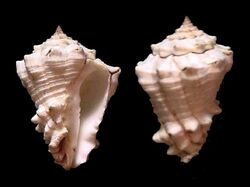Biology:Vasum muricatum
| Vasum muricatum | |
|---|---|

| |
| Two views of a shell of Vasum muricatum without periostracum from Los Roques archipelago, Venezuela | |
| Scientific classification | |
| Domain: | Eukaryota |
| Kingdom: | Animalia |
| Phylum: | Mollusca |
| Class: | Gastropoda |
| Subclass: | Caenogastropoda |
| Order: | Neogastropoda |
| Family: | Turbinellidae |
| Subfamily: | Vasinae |
| Genus: | Vasum |
| Species: | V. muricatum
|
| Binomial name | |
| Vasum muricatum (Born, 1778)
| |
| Synonyms[1] | |
| |
Vasum muricatum, common name the Caribbean vase, is a species of medium to large sea snail, a marine gastropod mollusk in the family Turbinellidae.[2][1]
Description
Vasum muricatum has a large, thick and heavy shell that reaches a length of 50 – 100 mm. The shell is quite elongated, conical or vase-shaped (hence the common name). There are blunt spines at the shoulder and near the base. The shell is off- white with black or dark brown periostracum externally, while the aperture is usually white. The columella has 5 strong folds, the first and third being the largest.[3]
Distribution
This species is widespread in the Caribbean Sea. In Venezuela this species has been reported from the state of Falcon,[4] Nueva Esparta[5][6][7] and Dependencias Federales.[8]
Habitat
This species is rather common and is often found in pairs in shallow water. It preys on worms and clams.[9]
Gallery
References
- ↑ 1.0 1.1 MolluscaBase eds. (2023). MolluscaBase. Vasum muricatum (Born, 1778). Accessed through: World Register of Marine Species at: https://www.marinespecies.org/aphia.php?p=taxdetails&id=420079 on 2023-01-28
- ↑ Morris, A. P. (1973): “A Field Guide to Shells of the Atlantic and Gulf Coasts and the West Indies”. Hougmon Mifflin Co Boston.
- ↑ Abbott, R Tucker (1974). American Seashells. D. Van Nostrand Reinhold. Ltd. New York. 663.
- ↑ Bitter, Ricardo S. y Martínez E. Rafael. 2001: Inventario de los moluscos marinos en las costas del estado Falcón, Venezuela. Acta Biologica Venezuelica, 21(1):21-41.
- ↑ Macsotay, O. 1982: Intervalos batimetabólicos y batimétricos de algunos moluscos bentónicos marinos de Venezuela. BOL. Soc. Ven. Cien. Nat. 37:103-147
- ↑ Princz, D. 1973: Moluscos gastrópodos y pelecipodos del Estado Nueva Esparta, Venezuela. Mem. Soc. Cien. Nat. La Salle, 33:169-222
- ↑ Princz, D y a González de Pacheco. 1981: Los moluscos marinos del Parque Nacional La Restinga, isla de Margarita, Venezuela. Ministerio del ambiente y de los Recursos Naturales Renovables. Serie informes cientifico. Zona 14/IC/1-42
- ↑ Capelo, J.C. y J. Buitrago. 1998: Distribución d e los moluscos marinos en el oriente de de Venezuela. Mem. Soc. Cien. Nat. La Salle, 150:109-160.
- ↑ Warmke, Germaine L. & Abbott, R Tucker. (1961): Caribbean Seashells. Livingston Publishing Company. Narberth. Pennsylvania.
- Rosenberg, G.; Moretzsohn, F.; García, E. F. (2009). Gastropoda (Mollusca) of the Gulf of Mexico, Pp. 579–699 in: Felder, D.L. and D.K. Camp (eds.), Gulf of Mexico–Origins, Waters, and Biota. Texas A&M Press, College Station, Texas.
External links
- orn, I. Von. (1778). Index rerum naturalium Musei Cæsarei Vindobonensis. Pars I.ma. Testacea. Verzeichniß der natürlichen Seltenheiten des k. k. Naturalien Cabinets zu Wien. Erster Theil. Schalthiere.
- Perry G. (1810-1811). Arcana: or the Museum of Natural History. pls. 1-48 (= 1810), pls. 49-84 (= 1811), unnumbered text pages. London: James Stratford.
- Röding, P. F. (1798). Museum Boltenianum sive Catalogus cimeliorum e tribus regnis naturæ quæ olim collegerat Joa. Fried Bolten, M. D. p. d. per XL. annos proto physicus Hamburgensis. Pars secunda continens Conchylia sive Testacea univalvia, bivalvia & multivalvia. Trapp, Hamburg. viii, 199 pp
- Lamarck,([J.-B. M.) de. (1822). Histoire naturelle des animaux sans vertèbres. Tome septième. Paris: published by the Author, 711 pp
- WoRMS
- ITIS
- Boldsystem
- Biodiversity Heritage Library
- EOL
- NCBI
- Smithsonian NMNH
Wikidata ☰ Q4498441 entry
 |





